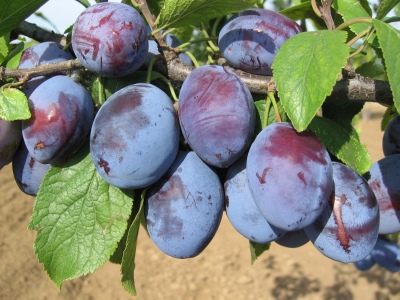
- Authors: A. Ya. Voronchikhina (Rossoshanskaya zonal experimental gardening station)
- Appeared when crossing: pollination of an elite seedling 59/28 x selected hybrids 54-13 and 57-46
- Year of approval: 1994
- Growth type: medium-sized
- Crown: broadly oval or hundred-like, spreading, medium density, with medium foliage
- Tree height, m: 4
- Fruit size: large
- Fruit weight, g: 38,5-60
- Fruit shape: elongated-oval and oval, unequal
- Fruit color: main - green, integumentary - dark purple, turning into brown-violet
Plum trees can often be found on summer cottages and farmlands. Particular preference is given to unpretentious, productive and frost-resistant species, including the Nika variety of domestic selection.
Breeding history
This variety appeared as a result of test work with different hybrid species carried out by the scientist A. Voronchikhina at the Rossoshansk zonal experimental station. The experiment used elite seedlings 59/28, selected hybrids 54-13 and 57-46. The plum species was entered into the State Register of the Russian Federation, and also approved for use in 1994. The crop is recommended for cultivation in the central regions of the country, however, due to frost resistance, the variety is productive in the northern part.
Description of the variety
Nika plum is a medium-sized tree that does not grow taller than 4 meters. It has a wide-oval crown with spreading branches and a moderate thickening of green-shiny leaves. Slightly curved shoots change color with age and become covered with longitudinal cracks, which is a distinctive feature of this species. Flowering occurs in the middle of the warm period - in the middle of May. At this time, the crown is covered with medium light flowers with corrugated petals, pleasantly fragrant.
Fruit characteristics
Plums belong to the class of large-fruited species, gaining weight from 38.5 to 60 grams. The fruits have an elongated-oval shape with uneven sides and a perfectly smooth surface. Plums have an unusual color, three-layered - from green to dark purple, turning into brown-purple. The peel of the fruit is firm, thick with a pronounced waxy bloom. Under the skin, if you look closely, you can see small dots. Inside the plum there is a small oblong stone, which can be easily separated from the pulp.
The purpose of plums is universal - they are eaten fresh, canned, processed into preserves, jams, marmalades, and fruits become limp in compotes. After harvesting, the crop can be transported over long distances, as well as stored for a long time in appropriate conditions (2-3 weeks).
Taste qualities
Nick's plums have excellent taste and marketability. The brownish-yellow pulp is characterized by excellent firmness and juiciness. When ripe, the pulp becomes tender and soft. The fruit has a balanced taste - bright sweet, with a subtle sourness and light astringency. Plums have no pronounced aroma.
Ripening and fruiting
The variety belongs to the group of mid-season species. The first harvest can be expected 4-5 years after planting. The tree bears fruit irregularly - the number of fruits directly depends on the vagaries of the weather. Mass ripening of fruits occurs in mid-August. Fruiting dates may shift slightly due to the peculiarities of the climate of the region.

Yield
Plum yield is excellent. If you provide a fruit tree with good care, then it will certainly thank you with a high yield. On average, up to 22.7 kg of plums can be harvested from 1 tree per season. With two pollinators, the yield increases to 35 kg.
Self-fertility and the need for pollinators
The plum species is self-fertile, so donor trees with similar flowering times will have to be grown on the site. The following varieties are considered the best pollinating trees - Vengerka Donetskaya, Voronezhskaya, Renklod Soviet, Pavlovskaya. In addition, bees and other insects contribute to pollination.
Growing and care
Spring is considered the best time to plant a plum seedling. The drain will comfortably grow in a sunny and draft-proof area. As a soil, fertile, air / moisture-permeable loams with neutral acidity will be ideal. Groundwater must run deep, otherwise moisture stagnation can harm the root system.
Comprehensive tree care consists of: irrigation (June, July and September, the root irrigation method is used), fertilizers (magnesium and nitrogen fertilization), sanitary pruning of branches, crown formation, pest and virus control, loosening and mulching of the soil. Preparation for winter involves covering the root zone with burlap.




Disease and pest resistance
Strong immunity protects the fruit tree from moniliosis and clasterosporium disease. Sometimes the culture is exposed to powdery mildew, olive and perforated spots, fruit rot. Spraying will help protect against the invasion of aphids, moths and fleas.

Despite the fact that plum is considered more hardy than many fruit trees, it is not immune from diseases. It is attacked by viral, fungal and bacterial infections, and parasitic insects harm it. It is necessary to notice and recognize the signs of plum disease in time. They are easier to deal with and defeat early on. Well, in order to protect the garden tree from such a misfortune in the future, preventive procedures can be carried out.
Resistance to soil and climatic conditions
Plum is frost-resistant, easily tolerates short-term drought, as well as prolonged heat. The tree is negatively affected by sudden temperature drops and excess moisture in the soil.



































































